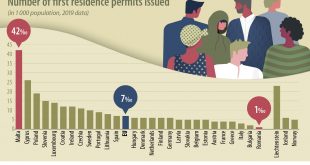Immigration is a hotly debated issue in the EU. To be more precise: immigration from the ‘south’ is hotly debated. Immigration from the East is much more important and increasing. Some facts: Immigration into the EU is increasing and has been increasing for quite some time (the ‘first residence permits’ mentioned in the graph and the quote are not permanent residence permits)This is to a considerable extent caused by immigration into Poland from countries like Ukraine and Belarus....
Read More »Logic and truth in economics
from Lars Syll To be ‘analytical’ and ‘logical’ is something most people find recommendable. These words have a positive connotation. Scientists think deeper than most other people because they use ‘logical’ and ‘analytical’ methods. In dictionaries, logic is often defined as “reasoning conducted or assessed according to strict principles of validity” and ‘analysis’ as having to do with “breaking something down.” But that’s not the whole picture. As used in science, analysis usually means...
Read More »Ecological Economics
from Asad Zaman Eurocentric history portrays the West as advanced, rational, scientific, and democratic, while the East is superstitious, unscientific, autocratic, and backwards. This poisonous philosophy enabled the incredibly brutal and ruthless violence required for the conquest of the globe, and continues to sustain extremely exploitative economic systems. A partial antidote is World Systems theory which portrays all human beings, nations, and cultures, as joint participants in...
Read More »Let the vaccinations begin…
Let’s start to vaccinate as many people as possible as soon as possible. This will, together with other technological solutions like air purifiers, UV-C lamps as well as large scale fast testing, enable us to escape the cycle of alternating lock downs. It will also enable us to at least pursue a policy of total eradication of Covid-19. Lock downs work – for a while. They can buy us time. But the economic, social and psychological consequences are immense and we will have to rely as much...
Read More »Diego Maradona (1960-2020): Some Bittersweet Reflections
Maradona was more than just an extraordinary footballer. He was also a complicated social icon. That further distinguishes him from other footballers, though Pele also has some of that… and it is great to see young footballers like Marcus Rashford taking up that mantle. He was both rewarded by and terribly exploited by the system. […]
Read More »‘Mathiness’ in economics
from Lars Syll In practice, what math does is let macro-economists locate the FWUTVs [facts with unknown truth values] farther away from the discussion of identification … Relying on a micro-foundation lets an author say, “Assume A, assume B, … blah blah blah … And so we have proven that P is true. Then the model is identified.” … Distributional assumptions about error terms are a good place to bury things because hardly anyone pays attention to them. Moreover, if a critic does see that...
Read More »ENGELS 200. Special Webinars on Friedrich Engels and his contribution to Marxism on the 200th anniversary of his birth, Saturday 28 November
ENGELS 200. Special Webinars on Friedrich Engels and his contribution to Marxism on the 200th anniversary of his birth, Saturday 28 November About this Event 10.00 am (UK time) Michael Roberts: Engels – the first critique of political economy Engels was the first Marxist before Marx and was first to develop of critique of contemporary economics and the nature of capitalism. Stavros Mavroudeas: Engels on editing Capital and defending Marx’s law of profitability Engels...
Read More »Be safe and innovative and love your family
A valid ontology for economics?
from Ikonoclast (originally a comment) The challenge is to develop a valid ontology for economics. In medicine, early theories of disease failed to yield efficacious treatments because their ontology (a theory of basic real existents and how they interact) was wrong. A few of the more common ideas founded on false ontologies were that diseases were caused by evil spirits, miasma and imbalances of the four humors. It was not until the advent of the germ theory of disease that real progress...
Read More »Where do libertarians stand on race? Glad you asked.
Almost all Americans agree that the government should not actively discriminate against blacks and other racial groups, and most believe that private race discrimination should be prohibited as well. Many people would go further and support efforts to reduce the large racial disparities that persist in America despite formal legal injunctions against discrimination. Some believe that schools and employers have a responsibility to eradicate subtle forms...
Read More » Heterodox
Heterodox



